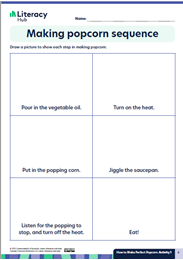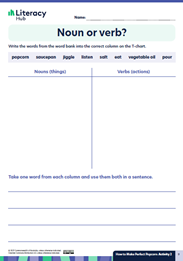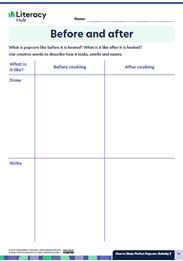How to Make Perfect Popcorn
This procedural text uses simple written steps and images to explain how to make popcorn.
Back to the shared reading overview page
Text download
How to Make Perfect Popcorn as PDF (2.7MB) (opens in new window)
How to Make Perfect Popcorn as PowerPoint slideshow (5.5MB) (download)
Printable worksheets
|
|
|
|

Teaching & learning sequence
This teaching and learning sequence outlines classroom strategies for How to Make Perfect Popcorn, including:
- ways to incorporate the ‘Big Six’ core elements of reading development
- fun, engaging and adaptable student activities for a diverse range of abilities
- links to the Australian Curriculum.
| Text features | Cross-curriculum links to the Australian Curriculum |
|
|

First read
As a whole group, enjoy sharing the text and learning together.
Engage
Have a whole-class discussion about food that students like to cook with their families. What foods do you like to cook at home? Who helps you to cook? How do you know what to do? Encourage students to share their personal experiences.
Make connections to prior knowledge. Do you like popcorn? Have you made it before? What did you do? Allow time for students to share their experiences.
Explain that you are going to share a procedural or instructional text about how to make popcorn. What do you know about procedural texts? What might we find out by reading a procedural text? Discuss as a group.
Read aloud
Show the first screen of How to Make Perfect Popcorn and read the title. What does the title tell us?
Read the list of things needed to complete the procedure.
Show screen two, and read through each of the numbered steps.
Make meaning
Discuss. What was the purpose of this text? Was it easy to understand? Are the instructions clear? Did the images help? How?
Discuss other types of procedural texts. What else do we need instructions for? (Building something such as construction toys or putting a model together, recipes such as how to make a cake, directions and rules for games.)
Revisit the text
Return to the text several times to look more closely at different aspects of its content, structure and language features. This is a great vehicle for exploring the ‘Big Six’ of literacy in an integrated way, with all components linking to the same text.
Comprehension
Reading is about making meaning. Choose from these comprehension activities to help your students explore the text deeply, make personal connections, develop new understandings, and draw conclusions. The activities will also help students analyse the text, think critically about it and form their own opinions.
Reading for a reason (whole-group activity)
Use the procedural text to make popcorn. This is a great opportunity to demonstrate reading for an authentic purpose. Read each step before carrying it out and then talk through what you are doing. Where appropriate invite students to undertake some of the steps that are safe for them.
Discuss. Are the instructions clear and easy to follow? How could these instructions be made clearer or improved?
Australian Curriculum links
Summarise the steps (partner activity)
Talk with the group about the main steps involved in making popcorn. Introduce the printable Making popcorn sequence printable worksheet and talk through each of the instructions.
Have students draw a picture in each box to support the written instruction. Have them cut out the six cards, swap them with a friend and put the set of cards back into the correct order.
Pairs could also use the two sets of cards to play a game of memory.
Print the Making popcorn sequence worksheet.
Australian Curriculum links
Phonological awareness (including phonemic awareness)
These activities will help students to hear the sounds and rhythms of language. Guide them as they explore syllables, onset and rime and listen for phonemes – the smallest units of sound within a word. Use the activities to help your students identify the phonemes in words and practise blending, segmenting and manipulating these sounds.
Isolating phonemes (whole-group activity)
Focus on the smaller word ‘pop’ within the word ‘popcorn’. Tell the students the sounds in the word by segmenting the phonemes: p, o and p. Have students turn to a partner and take turns saying the individual phonemes in the word. Say the sounds as a whole group.
Repeat with other words as appropriate to your students.
Australian Curriculum links
Alliteration (whole-group activity)
Focus on alliteration by highlighting the phrase ‘perfect popcorn’. When I say ‘perfect popcorn’, what do you notice? Discuss and draw out that both words start with the p sound.
Add an extra word to increase the alliteration pattern, for example, ‘perfect pink popcorn’. Invite students to add other words to the phrase and turn it into a tongue twister. ‘Patrick and his pretty pony ate perfect, pink popcorn and pepperoni pizza!’ Invite the students to say the tongue twister with you.
Use other types of food to repeat the activity. For example:
- Sizzling sausages: Salena’s sister ate sixty-six sensational sizzling sausages while sitting on a see saw.
- Tasty tuna on toast: Taj and Tan’s teacher ate tasty tuna on toast with tangy tomato tacos.
- Marvellous mangos: Mrs Markos met Mali Mae at the Merton morning market and ate millions of marvellous mangos.
Australian Curriculum links
Phonics
Evidence shows that children learn best about the relationship between phonemes and graphemes when instruction occurs through a daily structured synthetic phonics program (also known as systematic synthetic phonics). Knowing about these relationships will help students to decode, and this is crucial for their continued reading development.
In addition to your phonics program, it is helpful to expose students to letter–sound relationships they come across in other contexts, such as during shared reading experiences. Choose activities that are relevant to your students so they can practise and reinforce already learnt concepts, so as to build automaticity in recognising letter–sound relationships.
Matching letters to sounds (whole-group activity)
Use the tongue twister/s created earlier, for example, ‘Patrick and his pretty pony ate perfect, pink popcorn and pepperoni pizza!’, to focus on letter–sound correspondence. Write the tongue twister on a chart. Invite a student to circle all the letters that represent the p sound.
Have fun reading the tongue twister together as you point to each word.
Australian Curriculum links
Reinforcing vowel sounds (whole-group activity)
Reinforce your students’ knowledge of the r-controlled vowel sound or by focusing on the word ‘popcorn’. What sounds do you hear in the word corn? What letters represent the ‘or’ sound in ‘corn’?
Invite a student to write the word ‘popcorn’ and circle the letters ‘or’.
Have students talk with their partner about other words that have the or sound in them. Have them share their ideas and create a class list (for example, sauce, door, fork, sore/saw, talk, stork, pork). Circle the letters that make the or sound in each word. Highlight the different letter combinations that can represent the sound.
Australian Curriculum links
- Year 2: AC9E2LY09
Oral language
Oral language development begins at birth, and having a rich oral language is beneficial as a foundational and ongoing resource for literacy development. Oral language is embedded throughout the shared reading experience as students listen and respond to quality texts.
It is also valuable to involve students in specific activities that will continue to improve their oral language skills. Choose from these activities to help students develop and practise important communication skills.
Retelling (partner activity)
Have students sit with a partner and take turns retelling the sequence involved in making popcorn.
Remind students about their speaking and listening behaviours. Encourage them to speak using an appropriate volume that is not too loud and not too soft, and to use positive body language such as facing each other and nodding when listening.
Encourage students to check the text for accuracy after their retelling.
When required, support students by guiding them through the retelling as part of a teacher-led focus group.
Australian Curriculum links
What’s the rule? (whole-group activity)
Play a game such as ‘I spy’ with the group. After a few turns ask students to think about the rules. What are the rules for ‘I spy’? If someone didn’t know how to play ‘I spy’ how would you explain the game to them? Invite students to explain the rules of the game and how to play it.
Repeat with other simple games that the students know.
Australian Curriculum links
Fluency
Activities aimed at teaching and practising fluency are important for students on their journey towards becoming independent readers. Explicitly modelling fluency and providing opportunities for students to practise reading aloud are integral to this.
Paired reading (partner activity)
Print out screen two of How to Make Perfect Popcorn and, where appropriate, have students take turns reading a step each to a partner. Encourage students to focus on reading with fluency, and making their voice sound smooth.
Australian Curriculum links
Vocabulary
Having a rich, broad vocabulary assists students when they are tackling new texts. These vocabulary activities will help them to build their growing bank of words.
The activities introduce students to new Tier 2 and Tier 3 words, as well as exploring word families and a range of different word types.
Nouns and verbs (whole-group activity)
Revisit screen one of How to Make Perfect Popcorn, and read aloud. Which words in the list are ‘things’? (For example, saucepan, lid, vegetable oil, popcorn kernels, salt.) Explain that these words are nouns, and that nouns can be people, places or things.
Revisit screen two. Ask students to listen to the first word in each of the steps as you read aloud. What do the first words in each step have in common? Discuss and draw out that they are words that tell you what to do. They are all verbs.
List the verbs from the text on a chart (pour, add, turn on, listen, jiggle, turn off, wait, eat). Have pairs of students take turns saying one of the words from the list in a sentence. Challenge the pairs to say two words from the list in the one sentence.
Students can work further with nouns and verbs by completing the Noun or verb? printable worksheet.
Print the Noun or verb? worksheet.
Australian Curriculum links
Word families (whole-group activity)
Use the word ‘pop’ to explore word families. Ask students to find all the words in How to Make Perfect Popcorn that have the word ‘pop’ in them (popping, popped, popcorn).
Introduce other words with the word part ‘pop’ according to the level of understanding of your students (pops, lollypop, popular, unpopular, populate, population, overpopulate).
Explain that the word part ‘pop’ comes from a language called Latin, and it means ‘people’. Discuss words where students can make this link such as ‘popular’ and ‘population’.
Australian Curriculum links
Reflecting on learning
Discuss how the popcorn kernels changed when they were heated. What did they look like before being heated? What did they look like after being heated? How did you know the popcorn kernels were changing? Can they be changed back?
Print the Before and after worksheet for students to complete.
For families - new for 2024!Reinforce your classroom learning by telling families in your class about How to Make Perfect Popcorn. Families can share the text at home and use the information provided to build knowledge and instill a love of reading. Find out more about How to Make Perfect Popcorn (for families) |


